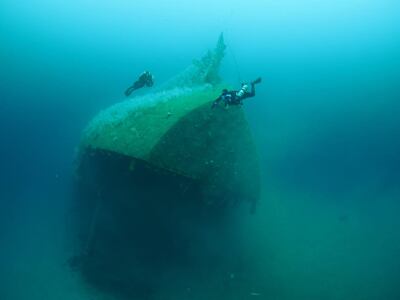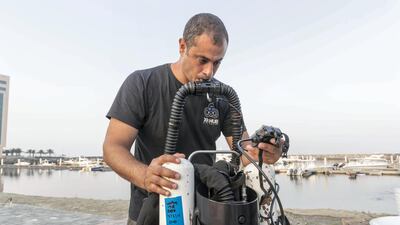The diver descends slowly, enveloped in silence with only fish for company. Deeper he goes, into the blue at 20 metres a minute until a hulking piece of metal looms from the depths.
“You could then spot the turret. It was a vessel frozen in time.”
More than two decades on, Simon Nadim still remembers every detail about his first deep-sea dive off the coast of Lebanon in 1996. Just a teenager then, Nadim dived 38m to the Souffleur - a Vichy France submarine torpedoed by Britain in 1941. “It was magical and unreal to be under the water experiencing this.”
It was the start of a life-long obsession. Mr Nadim, 40, has now completed 7,000 dives and runs his own centre in Fujairah. From his base at the marine club overlooking the Gulf of Oman, Mr Nadim organises dives, teaches and mixes breathing gases. When I meet him there, he is just off the boat. Tanks are slotted neatly into holders, dive suits hang from the walls while students are arriving for the next class.
But it was those early days in Lebanon that Mr Nadim recalls most clearly. As a child in his native Beirut, Mr Nadim explored the depths through the documentaries of French legend Jacques Cousteau. By his late teens, Mr Nadim was in the water, diving the wreck-laden seabed of Lebanon’s Mediterranean coast: Second World War-era submarines, downed British warplanes and numerous merchant ships and boats.

Many of these wrecks lie 100m or more down and divers must use complex equipment, diving computers and a special blend of gases to survive. Some use a rebreather - a diving apparatus that recycles exhaled oxygen – to cut down on the number of tanks carried. Anything below 30 metres is known as technical diving and the community in the UAE numbers up to 100. But Mr Nadim came of age in a time when the diving community did not enjoy the resources or technology available today. “It was much harder then. We knew less.”
Nonetheless by 1998 Mr Nadim had qualified as a "dive master" – meaning he can lead dive teams. Two years later, Mr Nadim became a dive instructor, which allows him to certify others. And in 2012, he visited the UAE for the first time to dive to the wreck of the German U-boat off the coast of Fujairah. It is an extremely challenging dive, 110m deep on the seabed with lethal currents and poor visibility. "It is rare to find submarines in such a good shape. We were accompanied by school of jackfish and I really liked it."
Tragedy surrounds most wrecks and the submarine is the final resting place for 52 German sailors. “You feel it. It is history. You respect their memory. You respect those people far away from their countries.”
Mr Nadim deeply appreciates the underwater world. Down in the blue, there is just immense silence and passing schools of fish. Some of the most famous wrecks he has dived include Britannic, the sister ship of the doomed Titanic. "The most beautiful wrecks are a bit deeper and you have to stay longer to appreciate them."
But the longer you stay, the longer you wait on the way back up to prevent decompression sickness or “the bends”. For Mr Nadim’s first 20-minute visit to the U-boat in 2012, he spent more than two hours on the ascent. Some divers even read to pass the time.
Mr Nadim moved permanently to the UAE a few years after that first dive to the U-boat and, in 2016, established the XR Hub Dive Centre. This year, he led a team that discovered the long-lost section of the oil tanker, Ines, that sank off Fujairah in 1999. "The best place to dive in the UAE is the east coast because of marine life, the depth and currents. You can even see mola mola [ocean sun fish]."
Mr Nadim stands almost two metres tall and has the air of someone you would call on in a crisis. Technical diving is generally safe but the sport can have a dark side. Jordanian Sultan Sabha went missing last year at the U-boat. Mr Nadim was closely involved in the search and found Sabha's camera and discarded gas tank. "It was an unfortunate chain of events," he says. Reserve divers should always be on the surface in case of emergency – something Sabha and his colleagues did not have. "It is very sad but this will save lives."
For now, Mr Nadim is getting ready for the new season. From September until December the temperatures and currents are ideal and for Mr Nadim, there is no better feeling that to be suspended in the water.
"I dive because it's an amazing feeling hovering without gravity, breathing in an incredible environment. We dive not to escape life, but for life not to escape us.
"I also have a passion to explore wreck and caves and diving offers unique opportunities to visit uncharted areas."
He now plans to continue his mission to find the Galvani – an Italian submarine shrouded in mystery that sunk off the UAE coast close to Iranian waters in 1940.
“It took a year to find the second part of Ines. So it takes time - I wish I had more of it.”
How divers dive deep:
Air consists of 21 per cent oxygen and 78 per cent nitrogen, with the remaining one per cent a mixture of other gases. A recreational diver can reach about 30 metres breathing air but going deeper would lead to a condition known as nitrogen narcosis, which is caused by inhaling pressurised nitrogen. Pure oxygen also becomes deadly even when inhaled at just 10m.
Technical divers overcome these problems by using a blend of helium, oxygen and nitrogen which is known as trimix.
Simon Nadim mixes these gases at his dive centre in Fujairah. Trimix is about 10 per cent oxygen, 60 per cent helium and the rest is nitrogen.
Another issue is decompression sickness, more commonly known as “the bends”. Pressurised gases that divers breathe are absorbed into body tissue. Therefore, they must make a slow return to the surface to let the gas out slowly. If divers ascend too quickly, the gas cannot escape and turns into a bubble and cause paralysis or even death.


